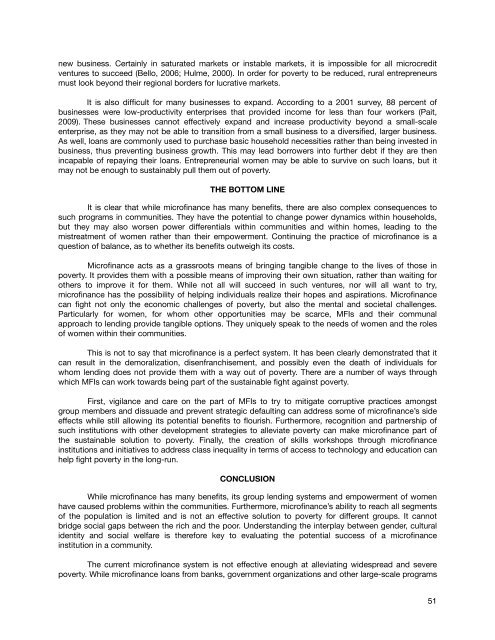Undercurrent-Issue-Fall-Winter-2014-3
Undercurrent-Issue-Fall-Winter-2014-3
Undercurrent-Issue-Fall-Winter-2014-3
Create successful ePaper yourself
Turn your PDF publications into a flip-book with our unique Google optimized e-Paper software.
new business. Certainly in saturated markets or instable markets, it is impossible for all microcreditventures to succeed (Bello, 2006; Hulme, 2000). In order for poverty to be reduced, rural entrepreneursmust look beyond their regional borders for lucrative markets.It is also difficult for many businesses to expand. According to a 2001 survey, 88 percent ofbusinesses were low-productivity enterprises that provided income for less than four workers (Pait,2009). These businesses cannot effectively expand and increase productivity beyond a small-scaleenterprise, as they may not be able to transition from a small business to a diversified, larger business.As well, loans are commonly used to purchase basic household necessities rather than being invested inbusiness, thus preventing business growth. This may lead borrowers into further debt if they are thenincapable of repaying their loans. Entrepreneurial women may be able to survive on such loans, but itmay not be enough to sustainably pull them out of poverty.THE BOTTOM LINE! It is clear that while microfinance has many benefits, there are also complex consequences tosuch programs in communities. They have the potential to change power dynamics within households,but they may also worsen power differentials within communities and within homes, leading to themistreatment of women rather than their empowerment. Continuing the practice of microfinance is aquestion of balance, as to whether its benefits outweigh its costs.! Microfinance acts as a grassroots means of bringing tangible change to the lives of those inpoverty. It provides them with a possible means of improving their own situation, rather than waiting forothers to improve it for them. While not all will succeed in such ventures, nor will all want to try,microfinance has the possibility of helping individuals realize their hopes and aspirations. Microfinancecan fight not only the economic challenges of poverty, but also the mental and societal challenges.Particularly for women, for whom other opportunities may be scarce, MFIs and their communalapproach to lending provide tangible options. They uniquely speak to the needs of women and the rolesof women within their communities.! This is not to say that microfinance is a perfect system. It has been clearly demonstrated that itcan result in the demoralization, disenfranchisement, and possibly even the death of individuals forwhom lending does not provide them with a way out of poverty. There are a number of ways throughwhich MFIs can work towards being part of the sustainable fight against poverty.First, vigilance and care on the part of MFIs to try to mitigate corruptive practices amongstgroup members and dissuade and prevent strategic defaulting can address some of microfinance’s sideeffects while still allowing its potential benefits to flourish. Furthermore, recognition and partnership ofsuch institutions with other development strategies to alleviate poverty can make microfinance part ofthe sustainable solution to poverty. Finally, the creation of skills workshops through microfinanceinstitutions and initiatives to address class inequality in terms of access to technology and education canhelp fight poverty in the long-run.CONCLUSIONWhile microfinance has many benefits, its group lending systems and empowerment of womenhave caused problems within the communities. Furthermore, microfinance’s ability to reach all segmentsof the population is limited and is not an effective solution to poverty for different groups. It cannotbridge social gaps between the rich and the poor. Understanding the interplay between gender, culturalidentity and social welfare is therefore key to evaluating the potential success of a microfinanceinstitution in a community.The current microfinance system is not effective enough at alleviating widespread and severepoverty. While microfinance loans from banks, government organizations and other large-scale programs51


